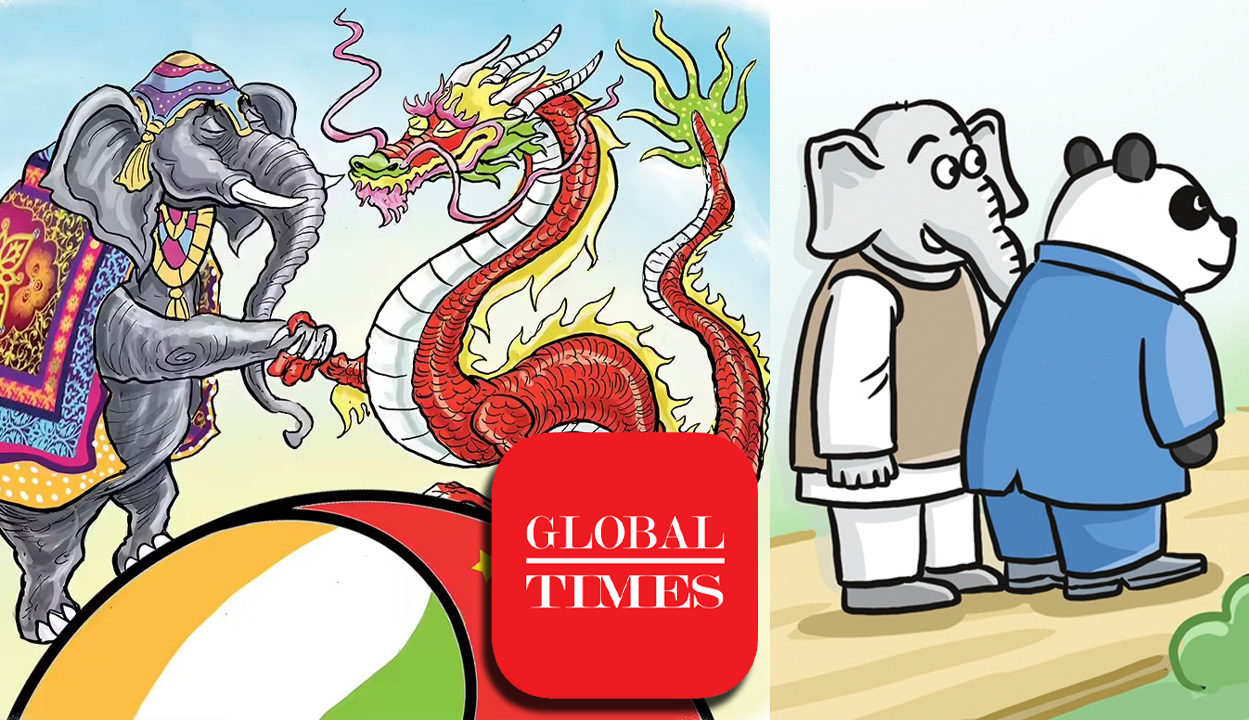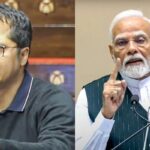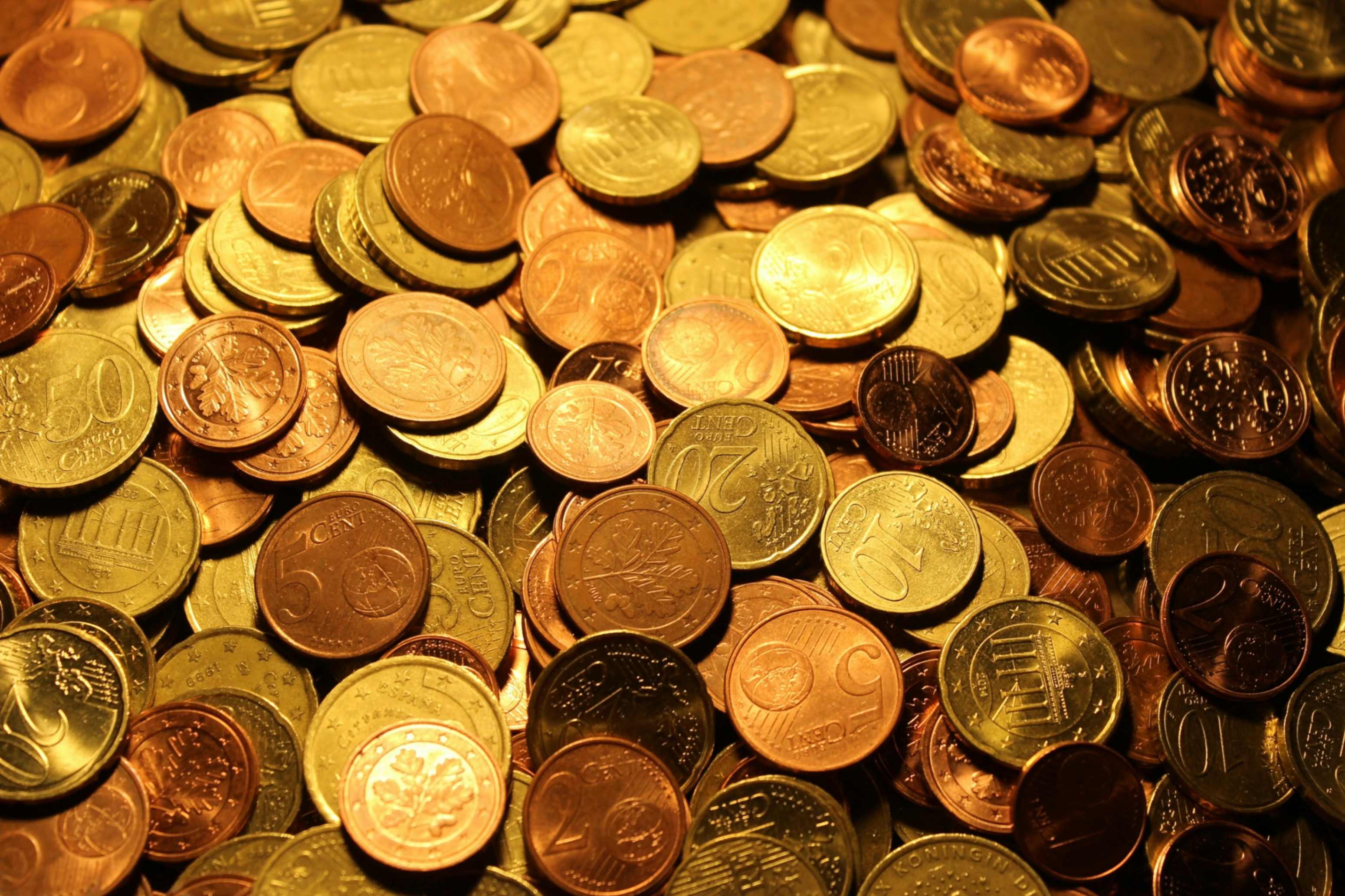One of the biggest unintended consequences of US President Donald Trump’s tariff war against BRICS nations has been to give a push to India and China’s potential reconciliation. Trump’s weaponisation of tariffs, aimed at weakening BRICS and ‘punishing’ India for its Russian oil purchases, has drawn sharp, though unexpected, criticism from China. As the shifting dynamics between India and China mark a fascinating turn in global geopolitics, the Chinese state media has also begun changing tones about India.
Chinese government mouthpiece, Global Times, which has a history of peddling anti-India narratives, has now been talking about development and friendship with India. From hawkish tones to softened rhetoric, it seems that Beijing does not want to miss the opportunity to bolster ties with India, in the face of Trump’s tariff imposing spree.
On 6th August, Global Times published an opinion piece headlined: “Why can’t India shake off the label of ‘graveyard for foreign investment’? The Chinese newspaper argued that the Western media-pushed “who will replace whom” between India and China holds little substantive value.

“India and China have a long history of cooperation and their economies are complementary. China highly values cooperation with India, and is one of India’s most important trade partners. In today’s complex and ever‑changing global landscape, rather than debating who replaces whom, it makes far more sense to utilize each other’s strengths, work on practical cooperation, and promote mutual benefit, win‑win outcomes and shared development,” the article reads.
It further highlighted a “critical juncture” in China-India relations, advocating for “practical cooperation” and “mutual benefit” to achieve “shared development.”
Taking to X, Yu Jing, the spokesperson of Chinese Embassy in India, said “Share with you an article @globaltimesnews. Western media create narrative of “who will replace whom” between #China and #India, which has little substantive value. In today’s complex landscape, it makes far more sense for both nations to deepen trust, manage disagreements, foster consensus, widen cooperation, and promote peace in Asia and globally.”
Jing also attached an image which showed an Elephant and Dragon being friends, with India and China as two halves of the world shown as Yin Yang symbol. The symbolism says it all!
Share with you an article @globaltimesnews. Western media create narrative of “who will replace whom” between #China and #India, which has little substantive value. In today’s complex landscape, it makes far more sense for both nations to deepen trust, manage disagreements,… pic.twitter.com/W0CUcX9FRL
— Yu Jing (@ChinaSpox_India) August 7, 2025
On 7th August, Global Times published an opinion piece authored by a Brazilian journalist, wherein it emphasized the significance of a multipolar world, strengthening of the Global South against US’s economic coercion.
“By trying to isolate and punish strategic partners in the Global South, the US achieves the exact opposite effect – bringing emerging economies closer together and strengthening cooperation mechanisms that reduce dependence on Washington,” the article states.

In another article put out on Thursday, Global Times highlighted that India, along with Brazil, is resisting against US tariffs. The newspaper cited a Chinese analyst’s comment that “India’s illusion that US will treat it with exceptional favor shattered.”

However, India never really was in this illusion that the US would treat India with exceptional favour. New Delhi very well understands that the US may consider India a key ally to counterbalance China, but Washington does not shy away from snubbing its ‘allies’ and ‘friends’ if they even slightly deviate from the US’s agenda. Thus, there is no question of any illusion being shattered.
If India had actually not been an equal partner in its ties with the US, India would have gladly genuflected before the US and signed the trade deal on Trump’s terms. India’s refusal to open its agriculture and dairy sector for the US at the cost of harming the livelihood of Indian farmers, New Delhi’s refusal to discontinue Russian oil purchase, as well as calling out the US and EU’s hypocrisy in the strongest words, demonstrates that India cannot be treated as an unequal partner. India is no Pakistan.
While India indeed is a counterweight to China in Asia, and US has also backed India in this respect, however, Washington misread India phenomenally when it thought that a ‘counterweight’ India would function as America’s vassal in the region. India’s presence in both, the BRICS bloc as well as QUAD should have made it clear that New Delhi’s strategic alignment is not one-sided. India, in principle and practice, believes in multipolarity, not in the global dominance of a single superpower.
Another article published in Global Times on 7th August, Global Times stressed that Reviving China-Russia-India (RIC) trilateral cooperation “must transcend symbolism”. “For all three, it represents a strategic opportunity to unite against external sanctions pressure, reaffirm foreign policy autonomy and advance a multipolar order,” states the article headlined: “RIC a strategic opportunity to advance multipolar order”.

In an editorial published on Thursday, Global Times said that “If India can take Modi’s visit as an opportunity to promptly adjust its China policy and remove unnecessary barriers, there will be much greater room for the development of China-India relations.”
Global Times pointed out that, unlike the Western media’s interpretation of PM Modi’s upcoming China visit as an attempt to “hedge against” the US, “Defending free trade and countering unilateral tariffs is the shared will of most countries in the world today.” It further highlighted that India and China, two ancient civilisations, emerging major economies and key members of the Global South, are a critical point in their modernisation journey. Welcoming PM Modi to visit China, the Global Times even cited a Hindu proverb, “Help your brother’s boat across, and your own will reach the shore.”

“As regional powers, China and India have extensive shared interests in areas such as counterterrorism, trade, and cultural exchange,” the GT article reads.
Indeed, China and India have many shared interests where the two neighbours can cooperate, especially in counterterrorism. China’s military and policy support to Pakistan, with the Pakistani Army being its de facto ruler, is deeply problematic to India. China backing a state sponsor of cross-border Jihadi terrorism against India is unacceptable to India, and for Sino-India ties to get any better, this pressing issue needs to be addressed by Beijing. India has not forgotten China’s defence support and vow to protect Pakistan against India when the latter launched Operation Sindoor in May this year.
For the Dragon and the Elephant to “dance together”, the Markhor needs to be kept in check. Pakistan’s pivot towards US, as reflected in the former’s Trump sycophancy, should be an eye opener for China that it’s ‘all weather’ ally is in reality, only dollar’s ally.
It is rightly said that the best thing about time is that it changes. Now that China is facing its own tariff battles with the US, Beijing sees value in aligning with India as a key partner and counterbalance against Western pressure. While China itself has had its ambitions of regional dominance and an expansionist agenda, it is now openly backing India’s advocacy of a multipolar world order against the US’s agenda of a rigid unipolar world order where Washington plays the ‘big brother’.
India has used various platforms, be it BRICS or SCO, to assert its vision of strategic autonomy and a balanced global order. China’s embrace of India’s vision, as reflected in the recent articles of Global Times, suggests Beijing’s willingness to find common ground with India and deepen ties while facing the bully (US) together. Now time alone will tell whether China genuinely wants to improve ties with India or it is a case of desperate times call for desperate measures.
While Global Times is now changing tones, it must not be forgotten how the Chinese daily has consistently been pushing anti-India narratives.
In May this year, when India launched Operation Sindoor against Pakistan’s terror and military establishments in the aftermath of the deadly Pak-sponsored Islamic terror attack in Pahalgam, Global Times, joined by other Chinese propaganda outlets like Xinhua, peddled fake news that Pakistan’s Chinese JF-17 jet destroyed India’s S-400 air defence system in Adampur, Punjab. It, however, turned out that the Chinese and Pakistani media were peddling blatant lies as the Indian Armed Forces refuted these claims by giving proper evidence.
Global Times had also amplified Pakistan ‘Aand’ Force’s fictitious and hilarious claims of having ‘paralysed’ 70% of India’s power grid through a cyberattack. These claims were also amplified by other Chinese state media outlets like Xinhua.

China.com had also reported that Pakistan’s fake claim of having destroyed a BrahMos missile storage facility in India. Similarly, Sina News had amplified Pakistan’s false claim that India targeted the Neelum-Jhelum hydropower station. Pakistani fake claims of capturing an Indian female pilot were also amplified by Chinese media platforms.
Not to forget, Chinese state media outlets like Xinhua had even reported the Pahalgam Islamic terror attack carried out by Pakistani terrorists belonging to the outfit Lashkar-e-Taiyba’s offshoot, The Resistance Front, as a ‘shooting incident’. Over two dozen innocent people were religiously singled out and shot dead for not being Muslims, and Chinese media downplayed the attack as just a ‘shooting incident’.
After Pakistan’s Chinese weapons failed against India in May, China relied on propaganda in Western media to save face and present the Indian military as weak, even as in reality, India rendered Pakistan’s Chinese air defence system defunct for a limited time period during its attack deep inside Pakistan.
This, however, has not been a new phenomenon. Chinese state media have been targeting India’s foreign policy as well as pushing sinister narratives pertaining to India’s domestic issues. OpIndia has reported earlier about Congress leader Rahul Gandhi’s China love; it however, has never been one-sided. Global Times and other Chinese media outlets have on many occasions, used Congress and Rahul Gandhi’s remarks to target India.

While China itself is infamous for its expansionist policies and hostile attitude towards neighbours over territorial sovereignty, Chinese state media is now stressing strategic autonomy and sovereignty. However, when India commissioned its second nuclear -powered ballistic missile submarine (SSBN), INS Arighat in August 2024, Global Times published a malicious piece titled ‘India’s second nuclear missile submarine should be used responsibly: experts’, virtue-signalling India over the ‘responsible use’ of its military arsenal.
Historically, India and China’s relations have been fraught with tensions, border disputes, especially Doklam (2017) and Galwan (2020) clashes, economic rivalry, strategic mistrust and differing geopolitical alignments. However, the winds are changing now.
The fresh efforts to resolve differences are promising, but India remains sceptical of China’s intentions. The Modi government sees Beijing’s advocacy of Sino-India friendship with cautious optimism.
However, Trump’s tariff tirade has inadvertently done the unthinkable—brought China and India on the same page. A tightly controlled Chinese state media’s shift in tone is significant. This confrontational-to-conciliatory shift signals a deliberate policy directive from Beijing. It seems that ahead of PM Modi’s China visit and amidst the ongoing tariff war, China is trying to bridge ideological and strategic gaps.
As ironic as it sounds, China’s pivot from rivalry to rapprochement suggests that Trump’s ‘America First’ dream, is turning out to be a ‘BRICS First’ reality.












